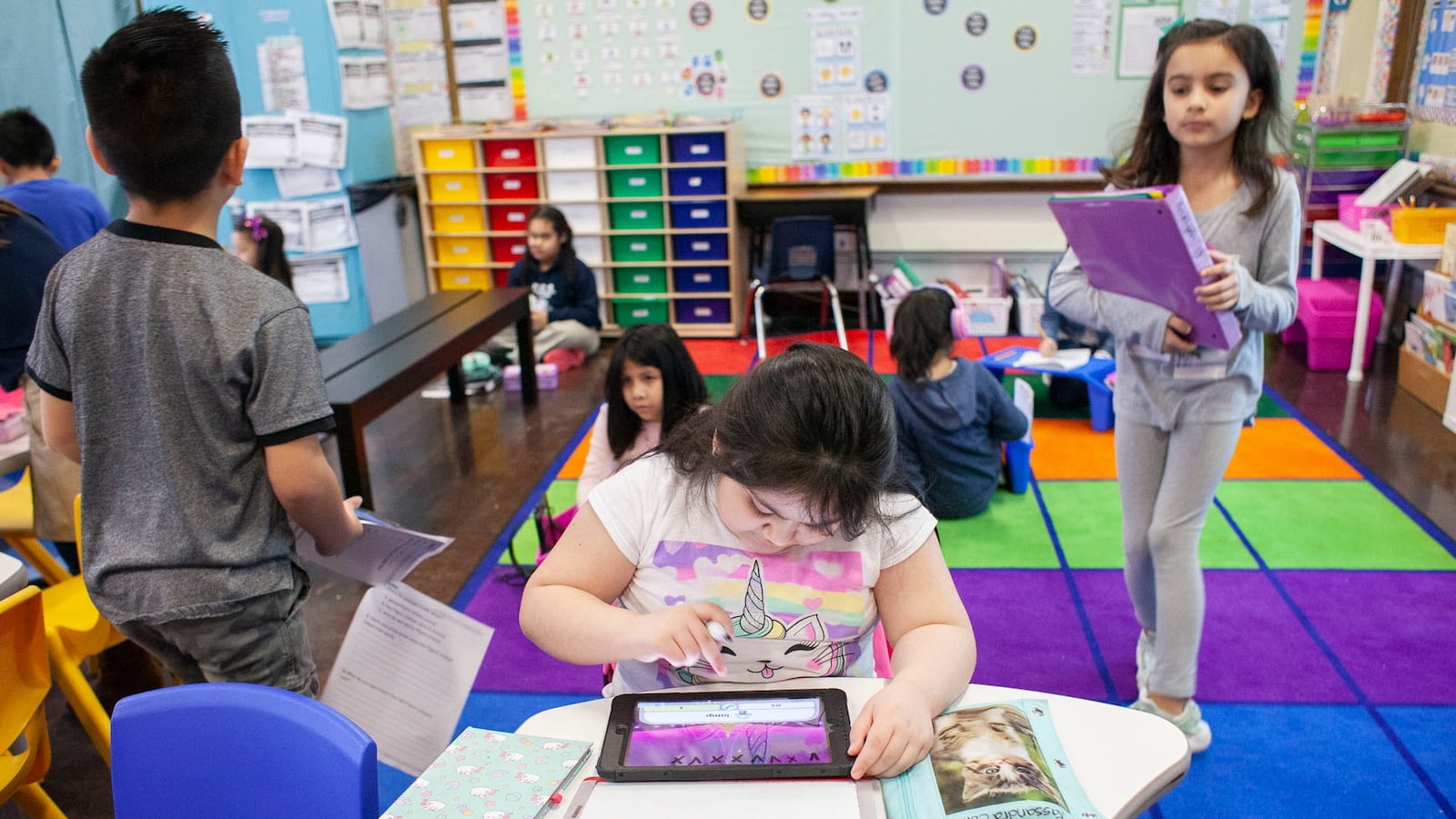On a recent day at CICS West Belden elementary, six primary students sitting in front of teacher Kelly Pollack listened raptly to her describing Native American techniques for building homes, hunting, and creating pottery.
Nearby, their classmates reclined on beanbag chairs or sat on brightly colored carpets, quietly doing history or science lessons on iPads. Pollack may not have had her eye on them, but her laptop was recording each one’s progress and tally of correct answers.
Pollack, a 17-year veteran teacher, heads what could be the classroom of the future. Her elementary school in the Belmont Cragin neighborhood on Chicago’s West Side sits at the vanguard of a movement known as personalized learning, an idea in education fueled by philanthropists and education reformers that customizing a student’s school experience can keep them more engaged and may even prepare them better for future careers.
Personalized learning harnesses technology to provide tailored lessons and hands the nitty-gritty of instruction over to computers. Teachers say that lightens the load of lesson planning and allows more time for them to work with small groups to reinforce learning.
As personalized learning has spread nationwide, philanthropic grants and enthusiastic district officials have turned Chicago into its epicenter.
Teachers like Pollack welcome it as a needed change to the classroom.
“I see it in the students, how excited they are,” she said. “It would be really hard to go back to a traditional way of teaching.”
Since January 2016, the Chan Zuckerberg Initiative has funneled $14 million to Leap Innovations, a Chicago-based non-profit that in turn has funded training and pilot programs in personalized learning. The group is run by Phyllis Lockett, an engineer of school choice and charter school expansion in Chicago. (Chan Zuckerberg also is a funder of Chalkbeat.)
About one-sixth of Chicago’s 600 public schools participate on some level in personalized learning — whether from attending training to converting entire classrooms to the method. The district budgeted $2.8 million for personalized learning initiatives this school year, about a 10% bump from last year’s spending, to train teachers, bring in new software and analyze education technology the district uses.
A new elementary building, still under construction in Belmont-Cragin, will be based entirely on the approach.
Personalized learning has proliferated among smaller charter networks that predominantly serve Chicago’s low-income students. Leap estimates that 90% of the students involved in its training and research programs are students of color.
But critics assail the program’s still unproven worth — with little solid academic research on its effectiveness — while some parents and educators oppose computer-centric education and the way low-income schools often become the testing places for new ed tech ideas.
***
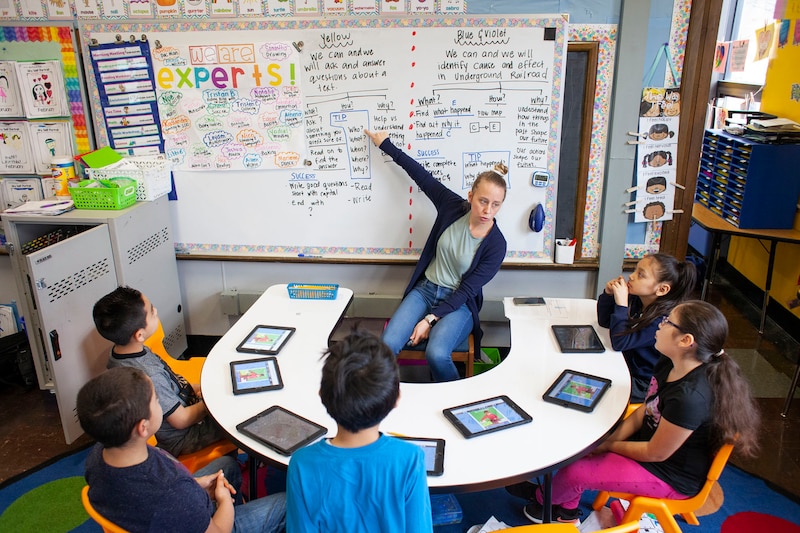
One morning at the CICS West Belden charter school, a fourth-grader sat on a bouncy black cushion and carefully took out her workbook and iPad, where she was watching a video about the California gold rush. Then she answered a series of multiple-choice questions. Nearby, a third-grader bounced up and down while working on his online lesson.
That day they were working independently in a mixed-grade classroom on an online assignment about panning gold. Being able to choose what to do illustrates the school’s learn-at-your-own-pace ethos. They could tackle worksheets, do a computer lesson, check their progress on their personal agendas, or, ask their neighbor for help.
The third-grader liked discussing subjects with people and working groups, while the fourth-grader preferred having time to work on projects and reading traditional paper books. Rather than hearing the iPad’s voiceover reading the text to her, she said she’d rather read it herself.
Those who got stuck can raise a hand for help from a classroom assistant or second teacher who occasionally assists. Or they could turn to the software for aid, or wait their turn with the teacher.
Personalized learning encapsulates some key ideas sweeping the education landscape — that students work best when their work is tailored to them, or that traditional testing may not fully capture a student’s growth — but takes the ideas further with a data-centered, software-learning approach.
At West Belden, a program called Lexia might guide students through a lesson about idioms, allowing a student to repeat questions or move back and forth between harder and easier examples.
The program may ask the meaning of an idiom, for example, “On his first day at his new school, Mario had butterflies in his stomach.”
If a student chooses the correct answer (“Mario was nervous about his new school”), she moves to the next question. If she chooses the wrong option (“Mario had a butterfly resting on his stomach”), she will be directed to a slightly easier idiom: “Cathy bit off more than she could chew when she agreed to make dinner for 30 people.”
If she gets this wrong, a screen will pop up explaining the correct answer. And if it happens a third time, the program flags a teacher.
Meanwhile, a centralized online dashboard records and tracks the progress of each student. Those needing help can sign up to speak to the teacher. Student profiles created earlier in the year list their likes, dislikes, and individual academic goals.
Students set their own goals, Pollack said. “Once they have choice in their learning, they are more excited.”
That echoes another education initiative re-examining grading called “competency-based education” — where students aim to master goals, rather than earn grades. That has taken off, especially in elite and private schools.
Students can take as much time as they need on each question, and have several weeks to move through a unit.
Pollack has taught at West Belden since 2002, and describes it as a “huge shift” from a more a traditional model. Moving to personalized learning has allowed her to focus more on each student’s needs.
For students who are struggling, the question-by-question data flags issues immediately. “Teachers are reteaching, enriching, or remediating based on the data they collect,” said Scott Frauenheim, who heads Distinctive, the management company that runs West Belden and several other charter schools under the umbrella of Chicago International Charter Schools.
At Leap, rather than passing or failing students, educators look at progress. “We never say that the student has failed, just that they haven’t gotten it right yet,” said Jeanette Moya, a trainer at Leap.
***
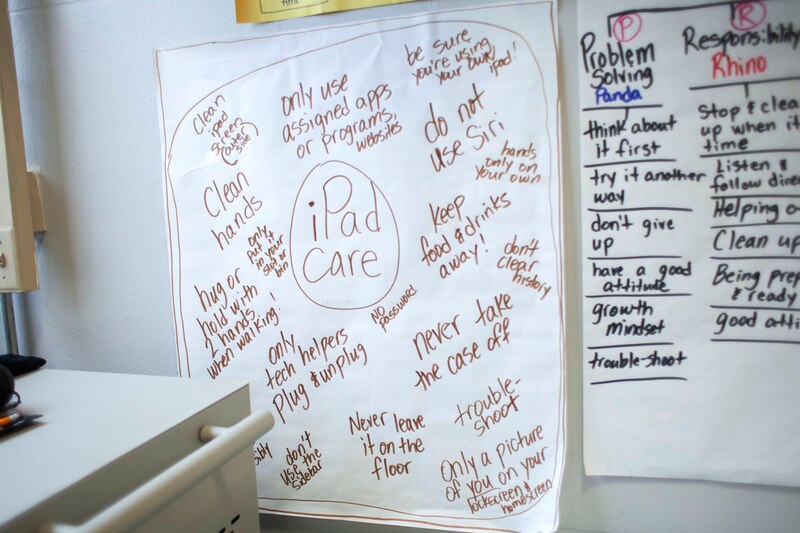
Personalized learning also raises bigger questions about the utility of learning online and the consequences of long periods spent on computers.
Diana Sharp, a former education researcher at Vanderbilt University and now an analyst with the New Hampshire-based think tank RMC Research, says customization is a positive.
“What we know about how people learn in general suggests that the more customized experience you have as a learner, the less time you’ll waste and the more interested you’ll be,” Sharp said. “I am optimistic about personalized learning.”
Leap’s internal research found a 13 percentage point increase in literacy in students who participated in a Leap pilot network compared with students in a control group. The group says outside scholars have validated Leap’s research methodology. Leap has cited Amelia Peterson at the Harvard Graduate School of Education, who said she thinks Leap’s internal research is credible. But her own work focuses on the ideas behind Leap, rather than its outcomes. There hasn’t been an external study of schools following Leap’s model.
Independent research on software-based learning is inconclusive, pointing to both bright spots and limitations. A 2009 study led by the U.S. Department of Education found that using math and reading software programs didn’t lead to any statistically significant increases in student test scores at most grade levels. Some studies have pointed to the benefits of specific technology programs, but the research about whole schools using these approaches remains in its infancy.
John Pane, a scientist at the Rand Corp. and a member of Leap’s research advisory board, said personalized learning simply hasn’t been in classrooms long enough.
“We really need to get better evidence on whether this is working in practice,” said Pane, whose research has found modest math gains among schools that adopt personalized learning approaches.
Leap’s approach has raised plenty of questions, too, from education experts who wonder whether a computer can accurately judge whether a student is learning. And some research suggests human relationships — with teachers and peers — are critical for academic success. It’s unclear how technology in the classroom might affect that.
Michael Kamil, a professor at the Stanford Graduate School of Education who specializes in education technology, cautioned against relying too heavily on computers.
“Different topics are better taught in groups and other topics are better taught individually,” Kamil said. “We have forgotten that sometimes there is vicarious learning, when you are learning while other students are answering a question.”
Kamil also questioned whether computer-based learning could effectively develop students’ critical thinking. “A computer is a fixed body of information. If we want to teach them to be critical, not have only right or wrong information, the computer has a hard time doing that,” he said.
Other critics mention concerns about potential adverse physical and mental effects of children spending hours every day looking at a screen.
As for computer time, Leap would not say how long students spend on computers every day. Distinctive sets the ideal amount at no more than 15 or 20 percent of the day, but it depends on the student. “It could be anything from zero time to 40 percent of the day,” said Kathleen McInerney, a second-grade teacher at West Belden. “There is no one percentage.”
***
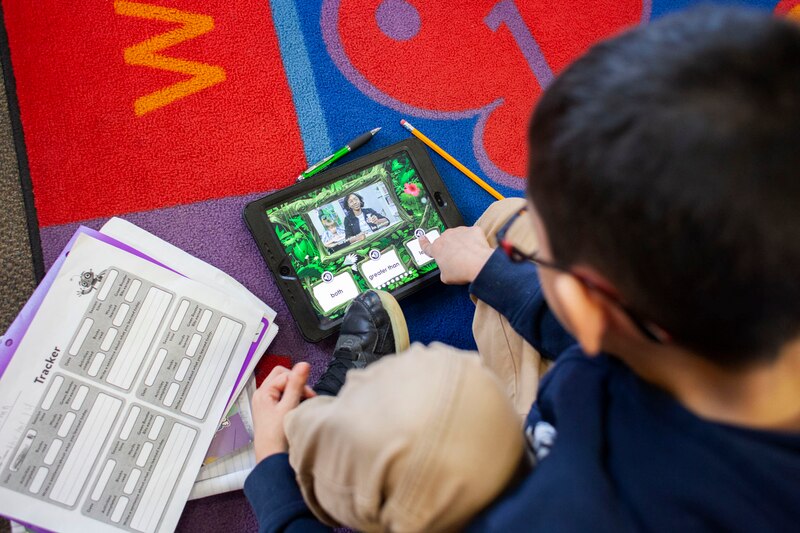
West Belden is typical of the schools where personalized learning has grown in Chicago. Its student body is 92 percent Latino, and 86 percent low income. Forty-seven percent of students are also English language learners.
The Distinctive charter network took over West Belden in 2011, and started its transition to personalized learning in the fall of 2013. Since then it’s been showered with funding for its personalized learning project, more than $300,000 in the first two years alone. While the school hasn’t grown, its enrollment has held steady, defying the districtwide decline in students..
What stands out in the pilot network program is the amount of training teachers received, a total of 102 hours over 18 months. Leap also minimizes lesson planning time because units follow plans in the software, and teachers end up with more time to collaborate during the school day.
“Before personalized learning, my whole Sundays would be dedicated to lesson planning,” Pollack said. Now, as students are not always relying on direction from a teacher, Pollack and other teachers are able to build planning and collaboration time into the school day. “We are able to have collaborative time every single day with other teachers on our team.”
But teachers at other personalized learning schools in the Distinctive network have had strikingly different experiences.
A former teacher who spent two years at CICS Prairie, a Level 2 school in West Roseland on Chicago’s Far South Side, described a staff with little training on personalized learning, and students being advanced grades without meeting the required academic benchmarks. He asked that his name be withheld because he still works in education.
After graduating with a bachelor’s of arts from a prestigious private university, he received one week of professional development at West Belden before taking over a third- and fourth-grade math class at Prairie. While there, he found that it was almost impossible to teach students math primarily through small groups and individual work and instead found whole-group instruction most effective at helping students grasp concepts.
“I didn’t teach in a personalized style, and the teachers that chose to take two to three kids at a time to work on specific exercises didn’t get great results,” he said. For example, “the lack of bilingual support meant that I couldn’t simply leave kids to work on a project.”
He left after two years with the impression that students were being advanced to the next grade even when they weren’t ready.
“If you tell me a student is going to lack a lot of their third-grade skills and then go on to fourth grade because they are all on their own path … it nearly brought me to tears,” he said. “Computers were this ultimate babysitter, and they were ever-present in the room.”
In response, Frauenheim, who heads Distinctive, said that for the last three or four years, teachers without prior training in personalized learning were given three weeks of professional development as part of an increased onboarding process.
He also noted that if a student wasn’t advancing, the school preferred to add additional support rather than hold back the student back a grade. “We give wraparound supports and services, and we also use a multi-age approaches to give students standards that they need regardless of age or grade level.”
***
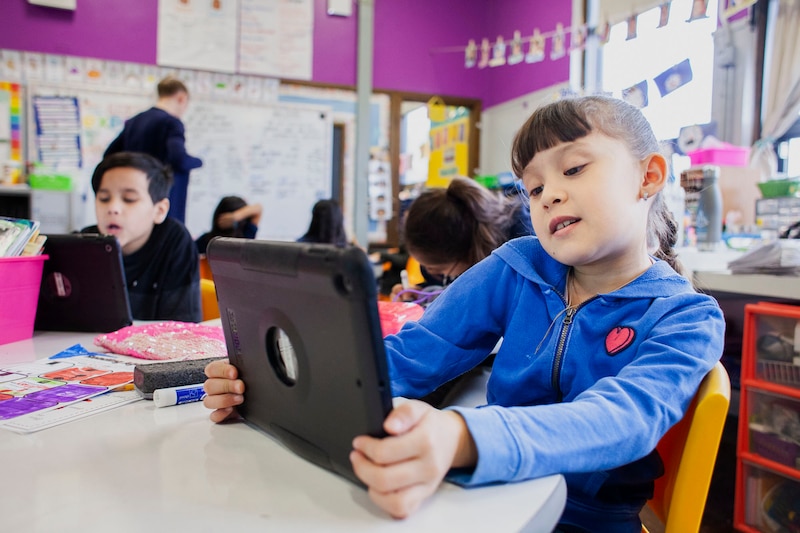
Even as personalized learning makes steady inroads, it still functions in a space of extremes.
Its supporters are almost evangelical in their fervor, promising a wholesale change to learning as we know it. “We are removing the mindset of desks and rows, of teachers doing all of the heavy lifting, of students tracking teachers all day long,” Frauenheim said. “We want to disrupt all of that.”
Detractors rail against “depersonalized learning” and the potential of taking teachers out of the classroom.
The students in Pollack’s class don’t know they’re caught in the middle of one of the next big educational debates. Asked what stands out to them about their school, they talk about its lack of a playground and a gym, but note that they like early dismissal and days when they can wear funny outfits to school.
They don’t think it’s remarkable that devices are used ubiquitously in school, a nod to the growing use of technology in young people’s lives, both in schools and outside of them.

